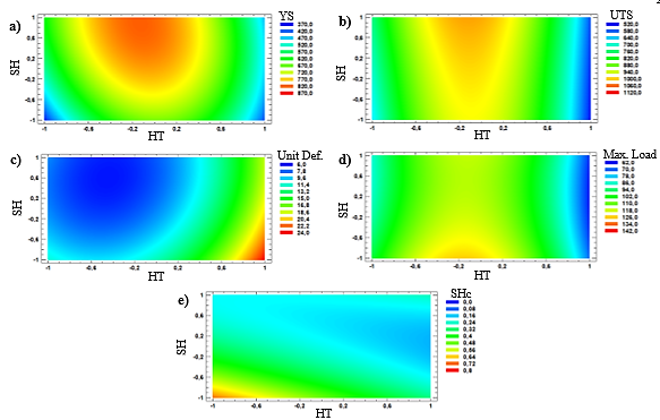
Publicado
Influence of quenching and annealing heat treatments on the strain hardening properties of AISI steels: a statistical approach
Influencia de los tratamientos térmicos de temple y recocido en las propiedades de endurecimiento por deformación de los aceros AISI: un enfoque estadístico
DOI:
https://doi.org/10.15446/dyna.v92n235.117273Palabras clave:
strain hardening, statistical analysis, prediction, RSM (en)endurecimiento por deformación, análisis estadístico, predicción, RSM (es)
Descargas
The knowledge of the stress-strain curve is of great interest due to the different parameters, conditions, and applications to which materials are exposed in different industrial sectors. This statistical study aims to analyze the strain-hardening behavior of two AISI-grade materials (1045 and 304). The ASTM E-8 standard procedure guidelines were considered for different hardening percentages due to plastic deformation (20% and 40%), following an experimental design of 45 tests, including repetitions. The results revealed an improvement in the material's mechanical properties corresponding to the hardening percentage, which was also correlated with the heat treatment process. Finally, response surface methodology plots were generated, depicting predictive equations governing the behavior of the response variables (stress, yield, load, and strain) with a confidence level of 98% in the results.
El conocimiento de la curva esfuerzo-deformación es de gran interés debido a los diversos parámetros, condiciones y aplicaciones a las que se ven expuestos los materiales en diferentes sectores industriales. Este estudio estadístico tiene como objetivo analizar el comportamiento de endurecimiento por deformación de dos materiales grado AISI (1045 y 304). Se consideraron los lineamientos de procedimiento de la norma ASTM E-8 para diferentes porcentajes de endurecimiento por deformación plástica (20% y 40%), siguiendo un diseño experimental de 45 ensayos, incluyendo repeticiones. Los resultados revelaron una mejora en las propiedades mecánicas del material correspondiente al porcentaje de endurecimiento, el cual también se correlacionó con el proceso de tratamiento térmico. Finalmente, se generaron gráficos de la metodología de superficie de respuesta, representando ecuaciones predictivas que gobiernan el comportamiento de las variables de respuesta (esfuerzo, fluencia, carga y deformación) con un nivel de confianza del 98% en los resultados.
Referencias
[1] Vargas-Cubillos L.F., Influencia del tratamiento térmico de recocido sobre la microestructura, dureza y atenuación ultrasónica de aceros inoxidables AISI 304, Universidad Libre, 2015.
[2] Rodríguez-Galbarro, H., Estudio y clasificación de los aceros, [online]. 2023. Available at: https://ingemecanica.com/tutorialsemanal/tutorialn101.html#google_vignette (accessed Dec. 12, 2023).
[3] Patiño-Pérez, A.P., Ortega-Breña, M., Rodríguez-Castro, R., y Ballesteros-Martínez, L., Caracterización, modelación y simulación de zona plástica para un acero de bajo contenido de carbono (AISI 1006), en: Congreso Iberoamericano de Ingeniería Mecánica, 2017, pp. 1–9.
[4] Salman, K.D., Microstructure and mechanical properties of cold rolled AISI 1018 Low Carbon Steel, IOP Conf. Ser. Mater. Sci. Eng., 551(1), art. 12007, 2019. DOI: https://doi.org10.1088/1757-899X/551/1/012007.
[5] Dimatteo, A., Colla, V., Lovicu, G., and Valentini, R., Strain hardening behavior prediction model for automotive high strength multiphase steels, Steel Res. Int., 86(12), pp. 1574–1582, 2015. DOI: https://doi.org/10.1002/srin.201400544.
[6] Bounezour, H., Laouar, L., Bourbia, M., and Ouzine, B., Effects of work hardening on mechanical metal properties—experimental analysis and simulation by experiments, Int. J. Adv. Manuf. Technol., 101(9), pp. 2475–2485, 2019. DOI: https://doi.org/10.1007/s00170-018-3071-x.
[7] Eom, J.G. et al., Effect of strain hardening capability on plastic deformation behaviors of material during metal forming, Mater. Des., 54, pp. 1010–1018, 2014. DOI: https://doi.org/10.1016/j.matdes.2013.08.101.
[8] Perez, W., Olaya, J.J., and Arenas, J.A., Influence of conditions of heat treatment on the mechanical properties of steel 5160H, Rev. Técnica la Fac. Ing. Univ. del Zulia, [Online]. 36(1), pp. 23–31, 2013. Available at: https://ve.scielo.org/scielo.php?script=sci_arttext&pid=S0254-07702013000100004&nrm=iso.
[9] Toribio, J. et al., Analysis of the bauschinger effect in cold drawn pearlitic steels, metals, 10(1), art. 10114, 2020. DOI: https://doi.org/10.3390/met10010114.
[10] Soria-Aguilar, M. de J. Efecto del tratamiento térmico sobre las propiedades mecánicas y microestructura de un acero para tubería API 5CT J55, Ing. Investig. y Tecnol., 16(4, pp. 539–550, 2015. DOI: https://doi.org/10.1016/j.riit.2015.09.006.
[11] Alexander P.W., y William, R.R., Análisis de las propiedades mecánicas de tensión, tenacidad y dureza de un acero SAE 1045 mediante los procesos de tratamiento térmico de temple, criogenia y revenido, Universidad Distrital Francisco José de Caldas, 2017.
[12] Vaca-Ortega, W.H., and Guerrero-Lara, E.S., Estudio de los tratamientos térmicos en el acero AISI 1045 en un sistema acuoso evaluados con la norma ASTM G105-89 que permitirá determinar la velocidad de desgaste del material, Universidad Técnica de Ambato, 2015.
[13] ASTM-E8/E8M, Standard test methods for tension testing of metallic materials 1, Annu. B. ASTM Stand. 4(C), pp. 1–27, 2010. DOI: https://doi.org/10.1520/E0008.
[14] García-León, R.A. et al., Effect of heat treatments on the strain hardening behavior of AISI 1045 and 304 Steels, J. Mater. Eng. Perform., pp. 1–16, 2024. DOI: https://doi.org/10.1007/s11665-024-10251-w.
[15] UAB, VII Endurecimiento por deformación y recocido, Universidad de Chile, Santiago de Chile, 2015.
[16] Afrin, N., Chen, D.L., Cao, X., and Jahazi, M., Strain hardening behavior of a friction stir welded magnesium alloy, Scr. Mater., 57(11), pp. 1004–1007, 2007. DOI: https://doi.org/10.1016/j.scriptamat.2007.08.001.
[17] García-León R.A. et al., Dry sliding wear test on borided AISI 316L stainless steel under ball-on-flat configuration: a statistical analysis, Tribol. Int., 157(May), art. 106885, 2021. DOI: https://doi.org/10.1016/j.triboint.2021.106885.
[18] García-León, R.A., Afanador-García, N., and Gómez-Camperos, J.A., Mechanical and dynamic maps of disc brakes under different operating conditions, Fluids, 6(10), art. 100363, 2021. DOI: https://doi.org/10.3390/fluids6100363.
[19] Statgraphics, Diseño de Experimentos –Diseños de Mezclas, Biblioteca Statgraphics, [online]. 2006. Available at: https://www.statgraphics.net/tutoriales/.
[20] Montgomery, D., and Runger, G., Applied statistics and probability for engineers, WILEY. United States of America, 2018.
[21] Singh, K.K., Strain hardening behaviour of 316L austenitic stainless steel, Mater. Sci. Technol., 20(9), pp. 1134–1142, 2004. DOI: https://doi.org/10.1179/026708304225022089.
[22] Hung, T.-P., Shi, H.-E., and Kuang, J.-H., Temperature modeling of AISI 1045 steel during surface hardening processes, Materials, 11(10), art. 101815, 2018. DOI: https://doi.org/10.3390/ma11101815.
[23] Garzón-Torres, J.R., Bohórquez-Avila, C.A., Hernandez, M.E., and Rojas-Molano, H.F., Influencia en las propiedades mecánicas del acero AISI-SAE 1045 tratado térmicamente con temple a temperatura intercrítica y revenido, Av. Investig. en Ing., 13(1) SE-Artículos, 2016. DOI: https://doi.org/10.18041/1794-4953/avances.2.257.
[24] Moghanizadeh, A., and Farzi, A., Effect of heat treatment on an AISI 304 austenitic stainless steel evaluated by the ultrasonic attenuation coefficient, 58(5), pp. 448–452, 2016. DOI: https://doi.org/10.3139/120.110878.
[25] Essoussi, H., Elmouhri, S., Ettaqi, S., and Essadiqi, E., Heat treatment effect on mechanical properties of AISI 304 austenitic stainless steel, Procedia Manuf., 32, pp. 883–888, 2019. DOI: https://doi.org/10.1016/j.promfg.2019.02.298.
Cómo citar
IEEE
ACM
ACS
APA
ABNT
Chicago
Harvard
MLA
Turabian
Vancouver
Descargar cita
Licencia
Derechos de autor 2025 DYNA

Esta obra está bajo una licencia internacional Creative Commons Atribución-NoComercial-SinDerivadas 4.0.
El autor o autores de un artículo aceptado para publicación en cualquiera de las revistas editadas por la facultad de Minas cederán la totalidad de los derechos patrimoniales a la Universidad Nacional de Colombia de manera gratuita, dentro de los cuáles se incluyen: el derecho a editar, publicar, reproducir y distribuir tanto en medios impresos como digitales, además de incluir en artículo en índices internacionales y/o bases de datos, de igual manera, se faculta a la editorial para utilizar las imágenes, tablas y/o cualquier material gráfico presentado en el artículo para el diseño de carátulas o posters de la misma revista.
















